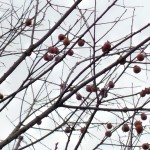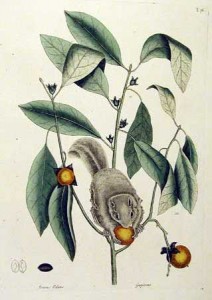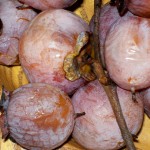20 Février, Wednesday
25 degrees F
Cloudy, Winds 5 N
Dreams of the approaching spring linger in these changeable days of February. In anticipation of the upcoming Jardin Potager season at Fort de Chartres, final orders of heirloom seeds are placed, the garden plans reworked, and the tools await sharpening. Soon the time for planning will be past. As part of my ritual of pre-season preparation I endeavor to bring order to the preserved remains of last year’s garden. Among the chores to be attended to are, clearing and organizing the stillroom and; inventorying last season’s dried herbs, gathered seeds, fruit preserves and brandies. Much to my delight, a dark corner of the room reveals a forgotten bottle containing late fall’s gathered persimmons, slightly bruised, sugared, and lightly spiced-left to mature in fine French brandy. In a week’s time, the brandy will be ready for decanting and tasting.
Finding this bounty allows me to revisit my ongoing obsession with this native fruit-Diospynos virginiana. While many happy hours are spent in the pursuit of research and cultivation of known 18th century vegetable and fruits of the French culinary traditions in the Illinois country, I am also much enamored of the native offerings of the region, the persimmon tree and fruit being one of many. The French called the tree plaqueminier or piaqueminier, the fruit-plaquemine. Piakimin, piakimine, piaguimina were the region’s Native American names for the persimmon tree and fruit. Not being able to successfully cultivate my own stand of persimmon trees, I have been known to stalk this wild native fruit, risking life and limb to gather quantities necessary to explore the 18th century recettes(recipes) which include this recalcitrant native fruit, underappreciated and now oft forgotten.
The tree presents an unassuming presence along the forests edge, often on a rocky slope. The persimmon is the only tree in the Illinois country of the Ebony family, its heartwood nearly black, maturing to a height of 30-70 ft. The branches keep a firm grip of the smallish orange fruit, reluctant to give up their bounty. Often the fruit is not fully ripe until after the first frost, the skin becoming a pale translucent orange with an overcast of light purple. Gathering the fruit from the ground signals its readiness, whether it falls naturally or one helps the process along by shaking the tree. The trick is to gather the now ripe fruit before the wild animals do, as it is a favorite. The delicious flavor is delicately sweet and its texture similar to a date. Jesuit Jacques Gravier wrote in 1701 that persimmons were “the most delicious fruit that the savages have from the Illinois to the sea.” The experience of tasting an unripe persimmon will leave a lasting impression, the sour astringency forever imprinting the experience in the mouth. Once the fruit is sufficiently ripe, the process for gaining the pulp from the fruit is difficult and messy. Not quite finished overcoming the persimmon’s intractable nature, one must now remove the many seeds from the pulp, requiring a bit of ingenuity and perseverance, employing a sieve to separate the fruit’s pulp from the attached seeds.
For all of the persimmon’s foibles, references abound concerning the native piakimias in the accounts of the Upper, Middle and Lower Mississippi Valleys written by 17th and 18th century French military and religious explorers such as Binneteau, Bossu, Charlevoix, Gravier, and Marest, to name a few. Their letters and journals note the presence of persimmon (the fruit often referred to as medlars or damask plums) throughout the Illinois country and its potential value. Pierre Francois Xavier de Charlevoix, a French Jesuit traveler and historian, in his Journal of a Voyage to North America remarked: “The Piakimine is shaped like a damask plum, though somewhat larger: its skin is tender, its substance watery, and colour red; and has besides a very delicate flavor.”
Tribes of the greater Mississippi River region such as the Osage, Illinois, and Quapaw utilized the fruit in food stuffs such as breads, puddings, and soup. In a late 17th century letter between Father Claude Chauteriere of Montreal to his brother Father P. Jean Chauteriere of Limoges, France states “I send you a piece of bread which has come from a place 500 leagues from here. It comes from the Illinois country; it is made from medlars or services, and has a very good taste.” Missionary Gravier reported receiving persimmon bread from a Quapaw chief: “He made me a present of 2 loves of piakimia, which I distributed among the French.” Military officer Jean-Bernard Bossu also referred to a type of native persimmon (ougoufle) bread, which may have been one of the first prepared foods sold by vendors on the streets of New Orleans. “The bread they make of it looks like gingerbread and it is dried for use on long trips.” Bossu also reports being offered by native hosts a meal of persimmon bread, bear paws, and beaver tails. Medicines were created from the bark and roots which were shared with missionaries and couriers du bois. The dry roasted seeds were used by colonists to make a kind of coffee-like beverage and were sometimes employed in games or weather forecasting. A period recipe from the Southeast instructs that the pulp mixed with bran was used in the making of colonial persimmon beer and there were also many references to persimmon brandy. The wood was valued for its strength and elasticity and was noted in its use for the making of many objects and tools, such as mallets, large screws, wagon chassis, shuttles and bows.
Exploring the French colonial foodways of the Illinois country, it becomes apparent the French utilized nature’s offerings. Whether through native tribal and slave interaction or intermarriage, local ingredients influenced colonial French cuisine while using traditional food preparation methods such as fricassees, sauces, baking, and preserving. Interestingly, other European colonists of the era seemed to resist the use of native food except when their ability to grow or obtain the known staples of their food culture was restricted. Persimmon fruit would have been a welcome addition to the diet of residents in the Upper Louisiana region, in savory and sweet “made dishes” whether fresh, dried, preserved, or fermented. Period and handed down recipes and narratives of our native persimmon fruit are featured on the Recettes 2013 page of this blog.
As the winter moves toward its completion, there is still time on cold evenings to savor the moment, pour a small glass of sweetly spiced persimmon brandy and be reminded of all the bounty, cultivated and native, present in the Illinois country. The coming spring and the gardening season ahead, will offer new opportunities to explore the colonial and native foods and recipes of those who inhabited this country of the Upper Mississippi called Illinois.
Our annual garden weekend at Fort de Chartres will be held Saturday and Sunday, February 23 and 24. Stop by and visit with a few l’habitants as work is done to prepare the jardin potager for the upcoming growing season, weather permitting. Jardin Potager heirloom seed packet samples will be available.
Information for this post gathered from primary sources:
Jean-Bernard Bossu’s Travels in the Interior of North America 1751-1762
Journal of a Voyage to North America, Translated from the French of Pierre Francois Xavier de Charlevoix, Vol. ll
The Jesuit Relations and Allied Documents, Travels and Explorations of the Jesuit Missionaries in New France, 1610—1791
The North American Sylva (1810), Translated from the French of F. Andrew Michaux
Additional references:
The common persimmon (Diospyros virginiana L.), The history of an underutilized fruit tree (16th-19th centuries), C. H. Briand (2005)
“A Wild Taste”: Food and Colonialism in Eighteenth-Century Louisiana, Shannon Lee Dowdy (2010)
Pigeon Soup and Plover in Pyramids: French Foodways in New France and the Illinois Country, Elizabeth M. Scott (2007)
The native persimmon, by W.F. Fletcher. (1915)




Just found your blog. You have lots of really interesting information. I like that! I always pick blogs that help me learn. Here on the shores of Lake Michigan, I can always learn something I can use in the gardens. Thanks. Jack
I grew up just south of Lake Erie and love the Great Lakes. The area is special to me as it is the birthplace of my love of gardening and history. Good luck with your gardens!